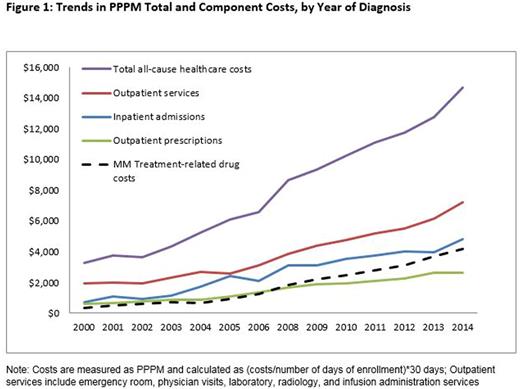Abstract
Introduction: There have been substantial advances in treatment options for multiple myeloma (MM) over the past 15 years, yet little real-world evidence is available to describe the recent trends in MM treatment costs and outcomes. This study aimed to examine the trends in novel therapy use, total healthcare costs, and survival outcomes among newly diagnosed MM patients in the US since 2000.
Methods: Patients aged ≥18 years who had ≥ 2 medical claims with MM (ICD-9 diagnosis code 203.0x) at least 30 days apart between January 2000 and September 2015 were identified in the Truven Health MarketScan Research Databases. Date of the first medical claim for MM was designated as index date. Patients were required to have 12-month pre-index and 3-month post-index continuous enrollment, and those with claims for MM treatment (including autologous stem-cell transplantation) in the pre-index period were excluded. Controls were selected from a pool of patients without MM and matched 1:1 with MM patients on index year, age, gender and geographic region. Patients whose death event could be obtained from the Social Security Administrations Master Death File were included in the survival outcomes analysis. Total healthcare costs were defined as sum of health-plan and patient paid costs for prescriptions and medical services, including inpatient admissions, emergency room, and physician office visits, and other outpatient services. MM treatment-related drug costs included outpatient pharmacy prescription costs and costs from outpatient services for infused products. Survival time was measured as time from index date to the date of death.
Results: 19,417 newly diagnosed MM patients were included (mean± SD age at diagnosis 65.9±12.3 years, 44.9% female), of which 18,260 patients were matched to controls. The percentage of MM patients using novel therapies (pomalidomide, carfilzomib, bortezomib, lenalidomide, or thalidomide) continuously increased from 8.7% in 2000 to 61.3% in 2014. Overall, 28% of MM patients did not receive any treatment within 1-year after diagnosis during the study period. Total per-patient-per-month (PPPM) all-cause healthcare costs increased from $3,263 in 2000 to $14,656 in 2014 among newly diagnosed MM patients, which were primarily driven by costs of outpatient services (Figure 1). Hospitalization costs accounted for 21.5% of total costs in 2000, which increased to 32.7% in 2014. MM treatment-related drug costs accounted for 10.6% of total costs in 2000, 23.6% in 2009, and 28.5% in 2014. Compared with MM patients diagnosed earlier, those diagnosed after 2010 had higher rates of novel therapy use and significantly better survival outcomes (Figure 2); patients diagnosed in 2012 were 1.25 times more likely to survive two years than patients diagnosed in 2006 while two-year survival among controls was fairly stable over the study period (94-97%). MM patients also showed improved survival outcomes over the study period, with the two-year survival gap between MM patients and their matched controls decreasing at a rate of 3% per year.
Conclusions: Findings from this study corroborate clinical data suggesting a paradigm shift in MM treatment over the past 15 years that is associated with substantial survival gains. Total healthcare costs among newly diagnosed MM patients have increased steadily since 2000 due to increases in all healthcare cost categories. However, the relative contribution of drug costs has remained fairly stable since 2009 despite new novel therapies coming to market in this time period. Future studies should focus on the impact of specific novel agents on patient survival, the value of clinical benefit engendered, and overall healthcare costs to better inform decision making in this setting.
Fonseca:Celgene, BMS, Bayer, Novartis, Sanofi, Janssen, Millennium a Takeda Company and AMGEN: Consultancy; Applied Bioscience: Consultancy; FISH: Patents & Royalties: Dr Fonseca has received a patent for the prognostication of MM based on genetic categorization by FISH of the disease. Abouzaid:Celgene Corporation: Employment, Equity Ownership, Research Funding. Bonafede:Truven Health: Other: I am an employee of Truven Health, which received a research contract to conduct this study with Seattle Genetics. . Cai:Truven Health Analytics: Other: I am an employee of Truven Health, which received a research contract to conduct this study with Seattle Genetics. , Research Funding. Parikh:Celgene Corporation: Employment, Equity Ownership, Research Funding. Cosler:Celgene: Consultancy. Richardson:Gentium S.p.A., Jazz Pharmaceuticals: Research Funding; Celgene, Novartis, Millennium Takeda, Gentium S.p.A., Jazz Pharmaceuticals: Membership on an entity's Board of Directors or advisory committees.
Author notes
Asterisk with author names denotes non-ASH members.



This feature is available to Subscribers Only
Sign In or Create an Account Close Modal